:quality(80)/business-review.eu/wp-content/uploads/2020/08/EquilibriumbySkanska.jpg)
Although the COVID-19 pandemic has undoubtedly changed the way we work around the world, people’s attitudes on this issue continued to evolve. From the total number of people interviewed, in March 2020, during the first wave of the pandemic, 39% of them went to the office every day. Currently, their percentage has increased to 49%. In Romania, the percentages range from 38% in March 2020 to 51% today. Going to the office every day or almost every day is more common among people who work in a team or among those who share with others their home as a workspace. Employees from all countries surveyed mention that the biggest advantages of working from the office are the ability to maintain the balance between work and personal life and the possibility of “face-to-face” conversations with teammates. These are just some of the conclusions drawn from a study carried out on behalf of the Skanska office development division in the CEE.
The study focuses on four countries in Central and Eastern Europe – Poland, the Czech Republic, Romania and Hungary. Its main aim was to analyze the current situation concerning work models on the labor market in terms of the COVID-19 pandemic. The results show how the perspective of employees has changed in the past twelve months and confirm that most of them are willing to get back to their offices.
The lack of a clear separation between work and home is seen as the biggest disadvantage of working from home (more than 40% of respondents say this). Limited social life and monotony are other disadvantages when working from home. One in four people complains about the high costs of maintaining their home, and also about the lack of equipment and infrastructure available at the office. About 1/3 of respondents say they lack the possibility to work from the office. In Romania, this desire is even bigger, almost half of the Romanians in the study said that they feel the need to work from the office.

No office, no connection
People with young children are more likely to complain about the limitations of working from home compared with the possibilities offered in an office space. Employees who work in a team go to the office much more often. According to the study, from the total number of the respondents who stated that they go to the office every day, 68% work in a team. They also believe that working from home is less efficient, and the lack of “face-to-face” discussions is mentioned much more often as a disadvantage of the home office in Romania compared to other countries (37% for RO, face 30% for CEE).
Over 50% of all respondents in Romania go to the office every day
In Romania, the percentage of people who worked from home in the first wave of the pandemic has decreased significantly in the last period, and the number of people who go to the office every day has reached 51%. The mental comfort of office work is highly appreciated by CEE employees who have children (almost 1/3 from the total of 19%) but also by people who have to share a room at home with their children (45% from the total of 19 %).

Those who work in the office appreciate that this allows them to maintain a work-life balance
“People are the most important asset of a company, and for us, their safety and well-being have always been a priority. The opportunity to go to the office, to work in a team, to communicate, to be with their colleagues, is a valuable part of daily life, allowing employees to maintain their effectiveness, creativity and mental comfort. The sense of belonging and human relationships are altered in the online environment.” says Anne-Marie Diaconu, Leasing & Asset Management Director at Skanska commercial development business unit in România.
Security as a key trend in returning to the office in 2021
According to the study, 57% of respondents indicate that safety certificates, such as the WELL Health-Safety Rating have a positive impact on their sense of security in the office , and in Romania, this percentage is even higher, reaching 64%.
The Skanska projects, Equilibrium 1 and Campus 6.2, are the first office buildings in Romania to obtain the WELL Health-Safety Rating, meeting the latest requirements imposed by the International WELL Building Institute forum for standard (multiple) locations. Skanska emphasizes the importance of building certification in order to give people the confidence they need to return to the office and intends to obtain WELL Health-Safety Rating for all its properties.

“It is very important for us that employees who return to the office feel safe from the first moment they walk through the access doors in the buildings until the end of the program, which is why we have implemented all the security measures since the beginning of the pandemic and until now.” adds Anne-Marie Diaconu.
In addition to the solutions implemented for its own employees, Skanska came up with a set of measures in support of all tenants in the Equilibrium 1 and Campus 6.3 buildings. For example, to keep fresh air in the same parameters as in the maximum density scenario considerably reduces the risk of contracting the virus. Also, we use a body temperature scanning system that restricts access to people with a temperature equal to or higher than 37.3 degrees. Nanoseptic foils were applied on the control panels of the elevators and on the handles of the access doors in all common areas (bathrooms, parking lots, etc.). Packages or food orders are brought / picked up outside the building, in a specially arranged area, where there is a storage space for couriers, called Easy box. A role in maintaining distance is also played by generous relaxation spaces, including outdoor ones that incorporate urban furniture and various facilities, such as wireless internet access.
About the study:
The study was conducted by the research and analytical company Zymetria on behalf of Skanska, the biggest office developer in Europe. As part of the quantitive online survey using the CAWI method, responses were collected from 1,200 office workers in four contries – Poland, Romania, the Czech Republic and Hungary.



:quality(80)/business-review.eu/wp-content/uploads/2024/07/Nadia-Comaneci.png)



:quality(80)/business-review.eu/wp-content/uploads/2024/06/22C0420_006.jpg)

:quality(80)/business-review.eu/wp-content/uploads/2024/06/COVER-1-4.jpg)



:quality(50)/business-review.eu/wp-content/uploads/2023/10/Screenshot-2023-10-20-at-3.37.38-PM.png)
:quality(80)/business-review.eu/wp-content/uploads/2024/06/br-june-2.jpg)
:quality(50)/business-review.eu/wp-content/uploads/2024/07/vodafone-RO.jpg)
:quality(50)/business-review.eu/wp-content/uploads/2024/07/BeFunky-collage-37-scaled.jpg)
:quality(50)/business-review.eu/wp-content/uploads/2024/07/04_ThinkPad_T14s_6_Business_Coworking.jpg)